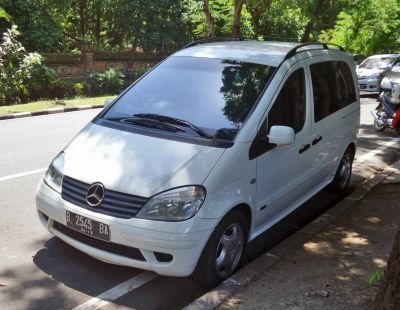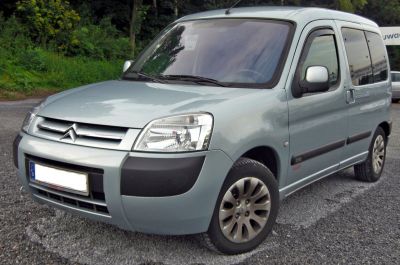 2002 Peugeot Partner I (Phase II, 2002) Dimensions, Size & Specs
2002 Peugeot Partner I (Phase II, 2002) Dimensions, Size & Specs
Measurements of the 2002 Peugeot Partner I, engineered for optimal performance and comfort
| Dimensions | |
|---|---|
| Length: | 4140 mm163.0 in13.6 ft |
| Width: | 1720 mm67.7 in5.6 ft |
| Height: | 1810 mm71.3 in5.9 ft |
| Trunk Capacity: | 625 liter22.1 cu ft |
| Trunk Capacity (Max): | 2800 liter98.9 cu ft |
| Weight Specifications | |
| Curb Weight: | 1190-1407 kg2624-3102 lbs |
| Maximal permitted Weight: | 1780-2040 kg3924-4497 lbs |
| Tire Specifications | |
| Rims Size: |
|
| Tire Sizes: |
|
The Peugeot Partner I Phase II, produced from 2002 to 2008, is a versatile minivan known for its practicality and efficient use of space. With a length of 4140 mm (163 inches), a width of 1720 mm (67.7 inches), and a height of 1810 mm (71.3 inches), the Partner I Phase II offers a compact yet spacious design that makes it ideal for urban driving and family use. This vehicle's curb weight ranges between 1190 and 1407 kilograms (2625 to 3102 pounds), while the maximum allowable weight varies from 1780 to 2040 kilograms (3924 to 4497 pounds), showcasing its capability to carry substantial loads despite its modest size. The Peugeot Partner I features a sizable luggage compartment with a capacity of 625 liters (22.1 cubic feet) under normal conditions, which expands dramatically to 2800 liters (98.9 cubic feet) when the rear seats are folded down, enhancing its cargo-carrying versatility for various transportation needs. Its wheel configuration includes 15-inch rims, compatible with tire sizes ranging from 175/70 R14 and 185/65 R14H to 205/65 R15H, providing a balance between comfort and stability. As a minivan, this Peugeot Partner generation combines practicality with efficient dimensions, making it a favorite in the compact MPV segment for those seeking a reliable vehicle with a generous interior and flexible storage options.
Discover the standout features that make the 2002 Peugeot Partner I a leader in its class
Have a question? Please check our knowledgebase first.
The Peugeot Partner I (Phase II, 2002) has a length of 4140 mm (approximately 163 inches), a width of 1720 mm (around 67.7 inches), and a height of 1810 mm (about 71.3 inches). These dimensions contribute to its compact minivan profile, suitable for urban and suburban driving while offering ample interior space.
The Peugeot Partner I (Phase II, 2002) offers a flexible luggage capacity tailored for various needs. With rear seats in place, the luggage space measures 625 liters (22.1 cubic feet), which is ample for daily use, groceries, or moderate travel luggage. When the rear seats are folded down, the luggage capacity dramatically increases to 2800 liters (98.9 cubic feet), making it very practical for transporting large items or bulky equipment, highlighting its versatility as a minivan.
The curb weight of the Peugeot Partner I (Phase II, 2002) ranges between 1190 kg and 1407 kg (approximately 2625 to 3103 lbs). Its maximum permissible weight ranges from 1780 kg to 2040 kg (about 3924 to 4497 lbs). The difference between these figures essentially represents the maximum payload capacity, i.e., the weight of passengers, cargo, and additional equipment the vehicle can safely carry. Depending on the variant, the payload capacity can range from roughly 373 kg to 850 kg (822 lbs to 1874 lbs), indicating a good load-carrying capability for a vehicle of its size.
Yes, the Peugeot Partner I (Phase II, 2002) fits comfortably into most standard garages. Its length of 4140 mm (163 inches), width of 1720 mm (67.7 inches), and height of 1810 mm (71.3 inches) comply with typical residential garage dimensions. Most standard garages are around 2400 mm wide and 4800 mm deep, so parking this vehicle inside should be straightforward without requiring modifications or special accommodations.
The Peugeot Partner I (Phase II, 2002) comes with rim sizes of 15 inches, and the supported tire sizes include 175/70 R14, 205/65 R15H, 185/65 R14H, and 185/65 R15. These sizing options provide a balance between ride comfort and handling performance. Generally, the 15-inch rims paired with the respective tire sizes support good road grip and cushioning over uneven surfaces, ensuring that the minivan is well-suited for both city driving and light cargo transport.
The Phase II update of the Peugeot Partner I, released in 2002, maintained a similar overall size compared to the original Partner I (Phase I) produced from 1996 to 2002. While the length, width, and height remained largely consistent, refinements in design improved interior space utilization and ergonomics. The updated Phase II also featured tweaks to exterior styling for a fresher look, but dimensions largely stayed close to the original, preserving the vehicle's compact yet practical minivan footprint.
Dimensionally, the Peugeot Partner I (Phase II, 2002) fits well within the compact minivan/small van segment. With its 4140 mm length and 1720 mm width, it is comparable to rivals like the Citroën Berlingo or Fiat Doblo, offering similar interior space and cargo capacity. Its height of 1810 mm also provides a spacious cabin environment, often exceeding traditional hatchbacks but remaining manageable for urban environments. The Peugeot Partner balances cargo versatility with city-friendly dimensions effectively compared to its peers.
The Peugeot Partner I (Phase II, 2002)'s relatively compact exterior dimensions of 4140 mm length and 1720 mm width make it highly maneuverable in urban settings. Its size allows for easier parking, navigating narrow streets, and handling tighter turns relative to larger vans and SUVs. The vehicle’s modest curb weight also contributes to responsive handling, making it suitable for city driving and commercial use where space efficiency and agility are important.
At a height of 1810 mm (71.3 inches), the Peugeot Partner I (Phase II, 2002) offers generous vertical space that translates into good interior headroom for passengers. This increased height helps ensure comfortable seating posture and an airy cabin feel, particularly beneficial for taller occupants or when carrying multiple passengers. The design enhances comfort during longer trips and supports the vehicle’s role as a family or utility minivan.
The Peugeot Partner I (Phase II, 2002) was offered with a range of petrol and diesel engines designed to balance efficiency and performance. Petrol engines typically ranged from 1.4 to 1.6 liters, while diesel options included 1.9-liter units known for their durability and economy. The vehicle's mechanical setup was tuned for practical urban and light commercial driving, with manual transmissions predominating. Overall, it offered reliable, fuel-efficient drivetrains suited to the varied needs of private consumers and business users.
Discover similar sized cars.

| Model Year: | 2001 |
|---|---|
| Length: | 4190 mm165.0 in |
| Width: | 1740 mm68.5 in |
| Height: | 1830 mm72.0 in |

| Production: | 2002-2008 |
|---|---|
| Model Year: | 2002 |
| Length: | 4137 mm162.9 in |
| Width: | 1724 mm67.9 in |
| Height: | 1810 mm71.3 in |
